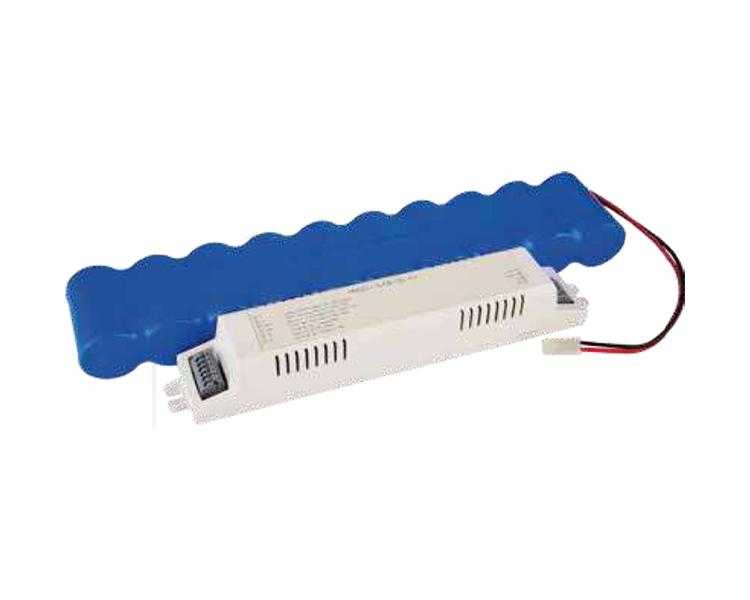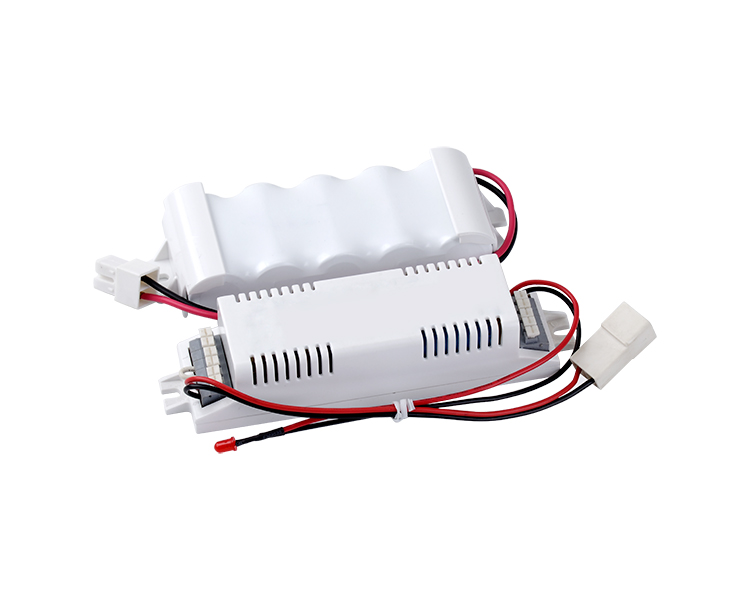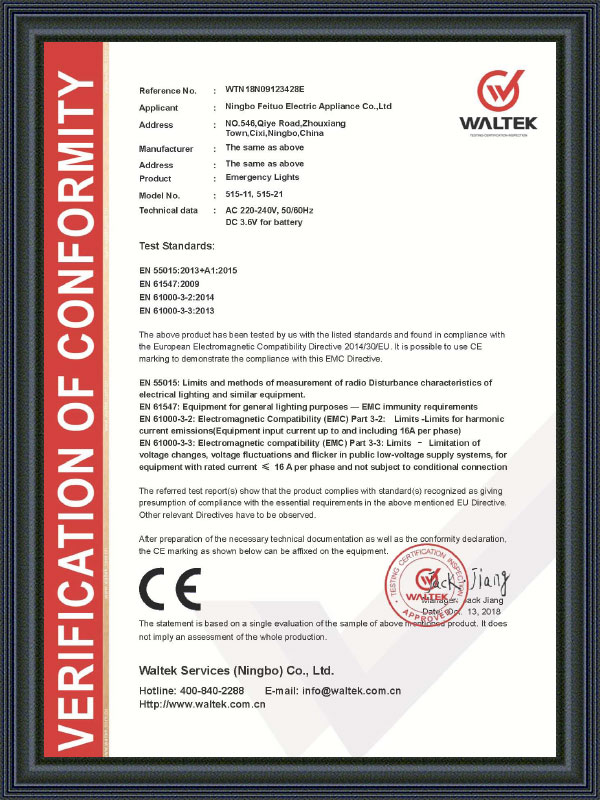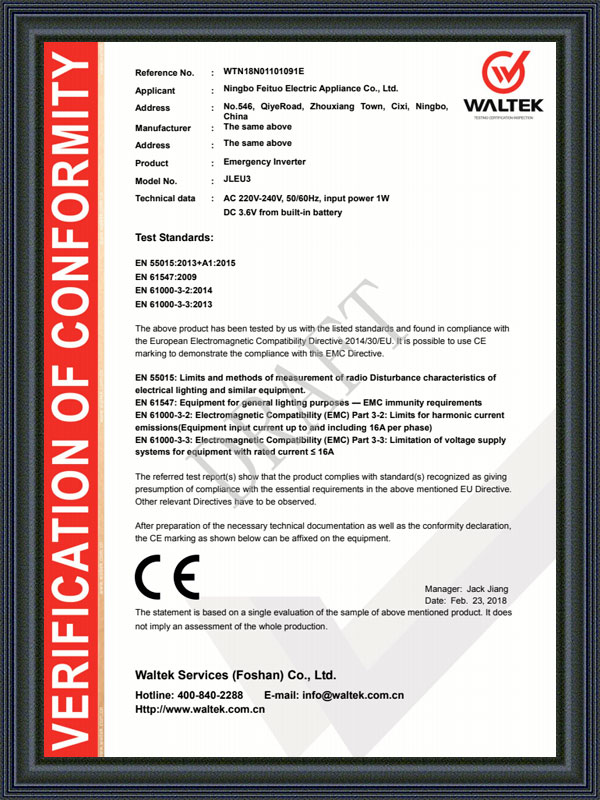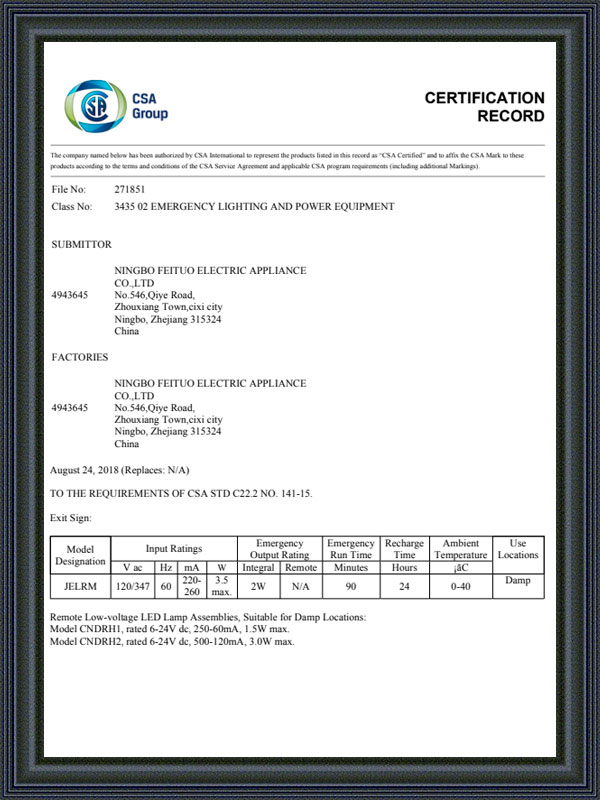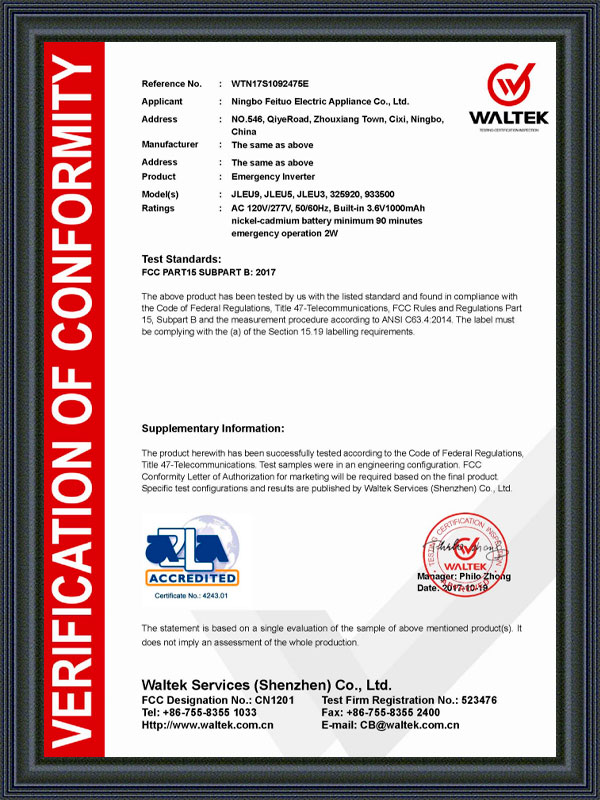Pachet de baterii de urgență cu LED pentru seria LED-JL...
Invertor de urgență LED
-
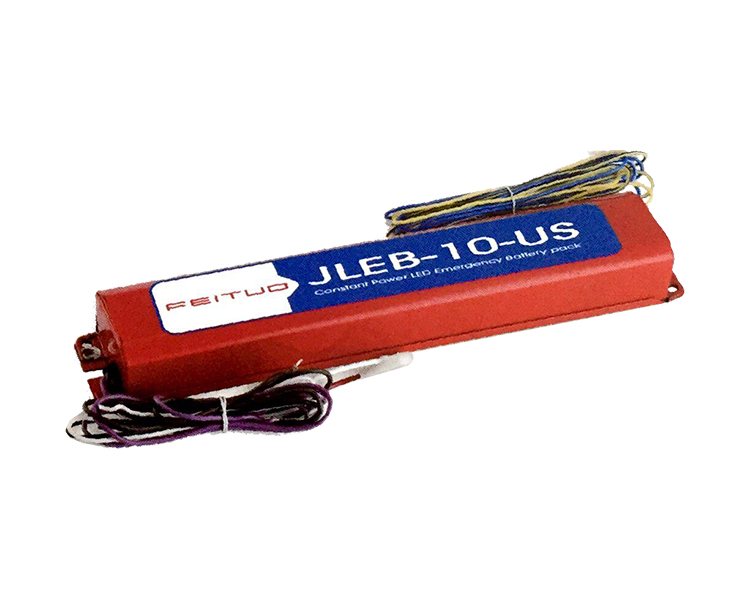
Funcționare de tensiune dublă Invertor de urgență
CITEŞTE MAI MULTPachet de baterii de urgență cu LED pentru seria ...
-
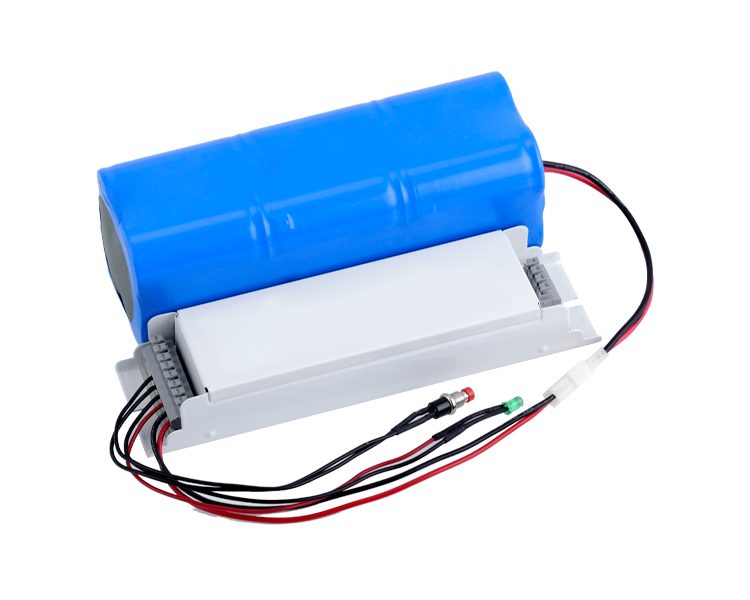
Pachet de baterii de urgență cu LED cu baterii externe
CITEŞTE MAI MULTPachet de baterii de urgență cu LED pentru...
-
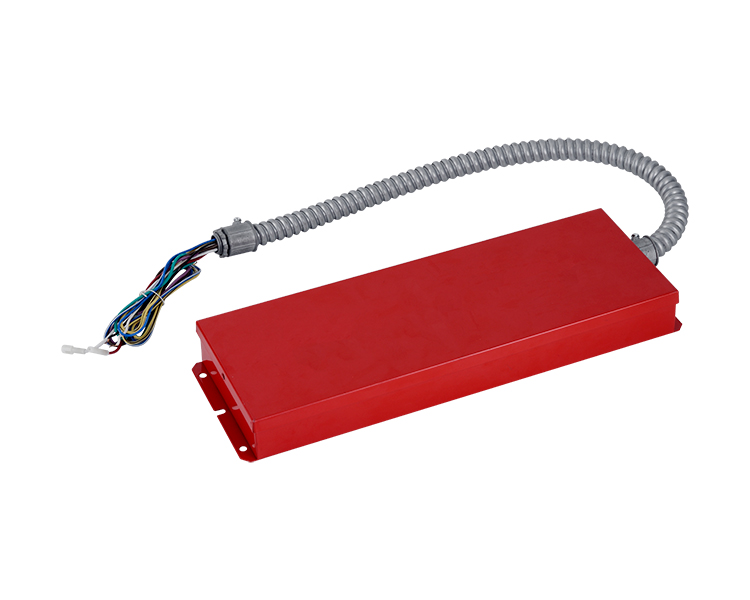
UL și Culus listate cu baterii LED de urgență LED
CITEŞTE MAI MULTPachet de baterii de urgență cu LED pentru...
-
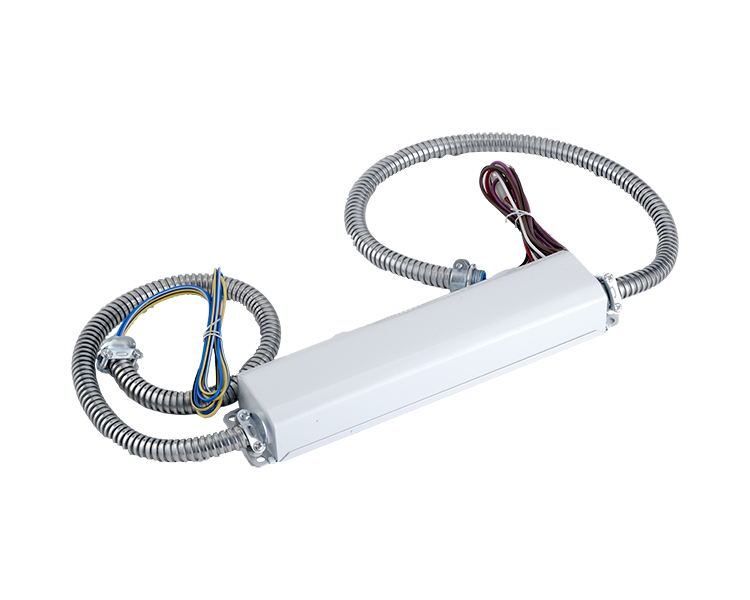
4W Invertor de urgență de ieșire constantă de putere
CITEŞTE MAI MULTPachet de baterii de urgență cu LE...
-
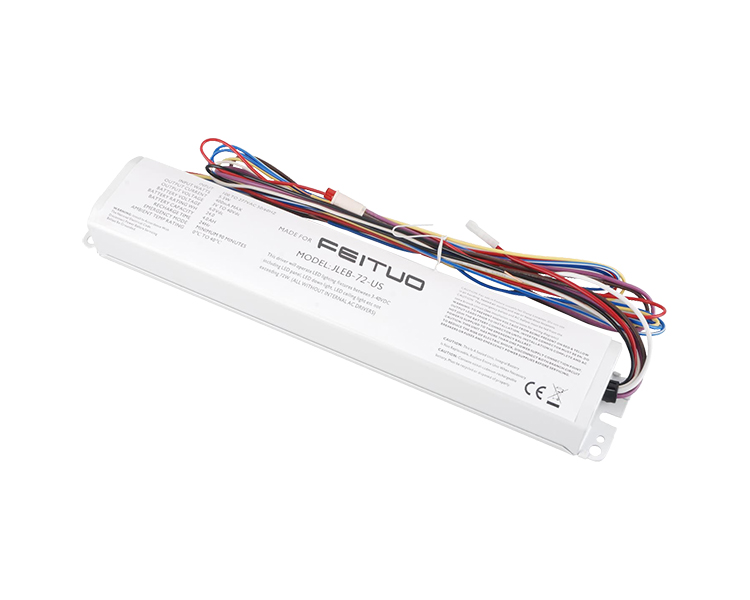
Pachet de baterii de urgență cu LED cu pachet intern de baterii
CITEŞTE MAI MULTPachet de baterii de urge...
-

Pachet de baterii de urgență LED
CITEŞTE MAI MULTPachet de baterii de urgență cu LED pentru seria LED-JLEB (8W, tip ...
Ningbo FEITUO Electric Appliance Co., Ltd.
Oferim certificatele corespunzătoare pentru a satisface cerințele de siguranță a pieței locale, cum ar fi CE / ROHS / UL etc. Fii angajat în industria de iluminat de urgență timp de 54 de ani OEM/ ODM/ SKD este binevenit
Încă de la înființare, Feituo nu a încetat niciodată să meargă în căutarea calității.
-

0
Stabilit
-

0+
Personal
-

02
Fabrica chineză
-

02
Fabrica Vietnam
-

0seturi
Capacitatea de producție
Acordați atenție ultimelor noastre știri și expoziții
-
Evoluții interesante și oportunități de parteneriat pe termen lung în soluții de iluminat de urgență!
Sperăm că acest mesaj vă va găsi bine. Suntem încântați să împărtășim câteva evoluții interesante de la compania noastră, un producător principal de semn de iluminat de urgență ...
-
Concluzie cu succes a târgului de toamnă din Hong Kong!
Târgul de toamnă din Hong Kong, un eveniment proeminent care evidențiază industria iluminatului, a atras numeroși expozanți și vizitatori atât de pe tărâmuri interne, cât...
-
Iluminați cu eficiență: Știința din spatele luminilor de urgență LED
Pe tărâmul iluminatului de urgență, fiarul eficient este absolut condus de era progresivă a Iluminare de urgență cu LED . În spatele scenei, acele dispozitive iluminatoar...
-
Evacuare inovatoare: rolul semnului de ieșire de urgență LED în situații de urgență
În internaționalul cu ritm rapid și imprevizibil în care rămânem, siguranța este primordială. Un detaliu important în asigurarea frumosului ființei ocupanților în condiții de ur...
Aveți un proiect în minte?
Hai să mergem la muncă!
Contact
Industrie Extinderea cunoștințelor
The feature of LED emergency inverter
The features of LED emergency inverters vary depending on the specific model and manufacturer, but here are some common features you might find in LED emergency inverters:
Automatic Switching:LED emergency inverters are designed to automatically switch to emergency mode when there is a power outage. This ensures continuous illumination during emergencies.
Compatibility with LED Fixtures:These inverters are specifically designed to work with LED lighting fixtures, providing emergency power to LED lamps or modules.
Sizing Options:LED emergency inverters come in various sizes and capacities to accommodate different LED lighting loads. It's important to select an inverter that matches the wattage requirements of the connected fixtures.
Battery Backup:LED emergency inverters are equipped with rechargeable batteries that provide power during outages. The capacity of the batteries determines how long the emergency lighting can operate.
Smart Charging Technology:Some inverters feature smart charging technology, optimizing the charging process to extend battery life and ensure quick recovery after power is restored.
Remote Testing and Monitoring:Advanced LED emergency inverters may offer remote testing and monitoring capabilities. This allows users to perform system tests, check the status, and receive alerts remotely.
User Interface:LED emergency inverters typically have a user interface, which may include indicator lights, buttons, or a display panel for monitoring and configuring the system.
Compatibility with Dimming Systems:Certain LED emergency inverters are compatible with dimmable LED fixtures, allowing for controlled dimming during emergency mode to conserve battery power.
How does the LED emergency inverter recharge its batteries?
The recharge process of LED emergency inverters depends on the specific design and technology used by the manufacturer.
Automatic Charging:Most LED emergency inverters have an automatic charging system. When the main power supply is restored after a power outage, the inverter automatically initiates the charging process for its batteries.
Constant Voltage Charging:The charging mechanism typically involves a constant voltage charging method. This means that the inverter supplies a constant voltage to the batteries during the charging process until they reach a specified level.
Float Charging:After the batteries reach the specified level, some inverters switch to a float charging mode. In float charging, a lower voltage is applied to the batteries to maintain their charge without overcharging, preventing damage to the batteries.
Temperature Compensation:Advanced LED emergency inverters may incorporate temperature compensation features. This involves adjusting the charging voltage based on the temperature to optimize the charging process and enhance battery performance.
Pulse Charging:Some inverters use pulse charging techniques, where the charging voltage is delivered in pulses rather than a continuous stream. This can be more energy-efficient and helps prevent overcharging.
Microprocessor Control:Many modern LED emergency inverters utilize microprocessor control for the charging process. The microprocessor monitors the battery status and adjusts the charging parameters accordingly to ensure optimal charging and battery health.
Fast Charging:Certain LED emergency inverters are designed with fast-charging capabilities. This allows for a quicker recharge of the batteries, reducing downtime between power outages.
Battery Protection Circuitry:To ensure the longevity of the batteries, LED emergency inverters often include built-in protection circuitry. This circuitry monitors the battery condition and prevents issues such as overcharging, which can lead to damage.
LED Indicators:LED indicators on the inverter may provide visual feedback on the charging status. Users can monitor these indicators to determine when the batteries are fully charged and ready for the next emergency event.
Information to be updated

